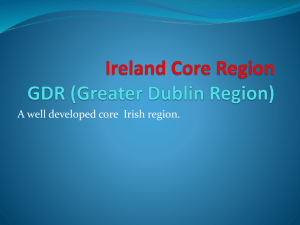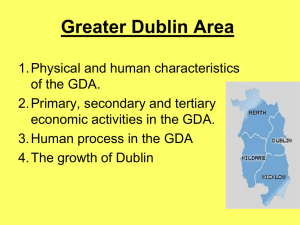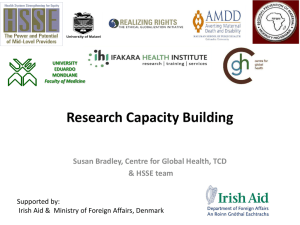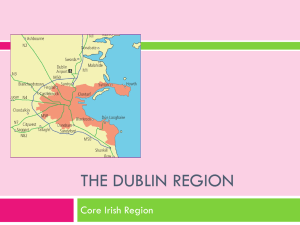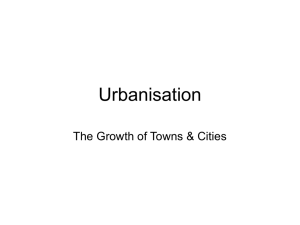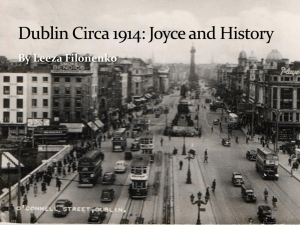File
advertisement
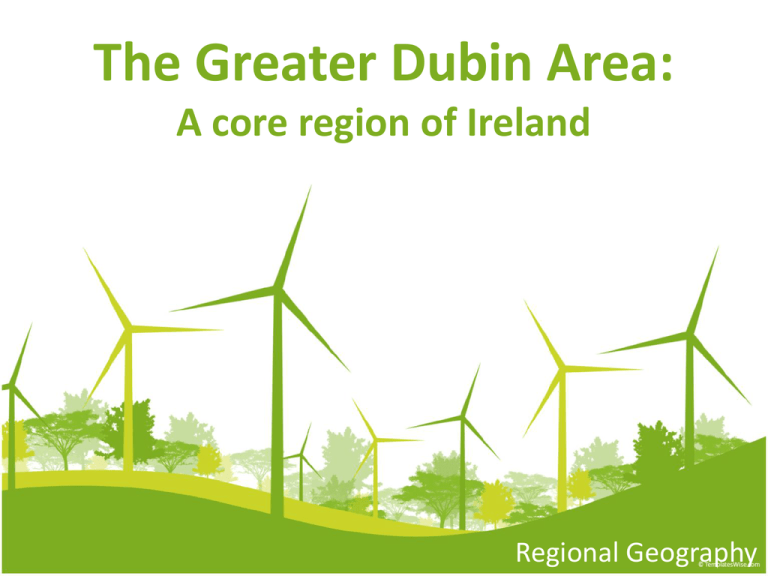
The Greater Dubin Area: A core region of Ireland Regional Geography • It is a focal point/nodal point of the main road and rail networks (with two sea ports and an international port) • It is the financial and administrative capital (with the seat of government). • Well-drained lowland area with fertile soils and sheltered harbours • High population density and in-migration • Attracts industry due to young, educated workforce. • It is a fast growing region. Primary Economic Activities: Farming (fishing, forestry and mining) Secondary Economic Activities: Industry Tertiary Economic Activities: Tourism (transport) Climate: The Cool Temperate Oceanic climate dominates Ireland. In this eastern region it brings the following conditions: Rainfall: approx. 750mm per year (higher in the Wicklow mountains=relief rain) Temperatures: 5 – 15 ◦C on average. Relief: The land of this region is mostly low lying and gently sloping especially throughout much of Meath, Kildare and Dublin. However, the Dublin/Wicklow mountains hinder development further south in these counties. Drainage: The Liffey dominates much of Dublin and Kildare with other rivers in the region including the Boyne, Nanny, Blackwater and Dargle. Drainage: The Liffey dominates much of Dublin and Kildare with other rivers in the region including the Boyne, Nanny, Blackwater and Dargle. Soils: The GDA is mostly covered in a fertile layer of Brown Earth Soils. This soil is mixed with glacial boulder clay dropped thousands of years ago and irrigated by the rivers of the region. Also these rivers provide rich alluvium each year making the area ideal for agriculture. Peaty soil is found in the mountainous areas. The climate and the soil of this region helps agriculture in this region. The low rainfall amount (750mm), rare frosts and the gently sloping landscape (covered in brown earth soils and loam soils) sees ideal conditions for profitable farming. Cereals are grown in Meath and Kildare with immigrant workers needed for the barley and maize crops. Wheat is also produced in these counties. Agriculture in the GDA is intensive. This means that crops are grown quickly and efficiently for the large local market of the region. Horticulture and tillage farming are the main types of farming and are profitable as the produce is locally transported and sold. The north of County Dublin is the location of over half of all green houses in Ireland. Here fruit and vegetables are grown. Cabbages, tomatoes and onions are some of the main produces of this region. Cattle farming takes place in most of County Meath. In fact many farmers in the West of Ireland send their cattle to this region for fattening prior to selling them on the market. Kildare specialises in the bloodstock industry (horses) with the Curragh nearby. In County Wicklow sheep rearing is practiced on the sloping low hills of the Wicklow Mountains as soil cover is thinner and unsuitable to crops. The greatest challenge facing agriculture in this region is the growth of Dublin city and all the main towns of this region. The demand for land and crops conflict each other. Wicklow has more land under forestry than Kildare, Meath and Dublin combined. This is because this county is home to the Wicklow mountains which have thin, acidic soils unsuitable for most crops and farming practices. Instead the land is used to grow trees. The northfacing slopes are solely used for tree growth as these slopes are colder, wetter and farming is extremely difficult on the steep slopes. Howth in North County Dublin is home to the fishing industry in this core region. This fishing port and town ranks at number three in Ireland for fish landed and for the employment of people in fish processing. Dublin Bay Prawns are one of Irelands premier shellfish exports. 40% of all exports from Ireland in 2005 were prawns from this region. Oysters and shrimps are also caught and exported. The GDA has many advantages for attracting industries: • • • • • • • Transport Network Port Raw materials Population Education Standards of living Service centre Manufacturing is the main type of industry in this region. Due to the strong agriculture base in these counties there is a wide variety of food processing, clothing and textiles and electronics. Dublin county makes up 32% of employment in manufacturing alone. The main companies in this region are: Dell Computers in Cherrywood, Dublin. Despite the downturn in the economy over 1000 people are still employed in this location. They are responsible for making, servicing and tele-sales computers and other machinery. Other IT companies include Hewlett Packard and Intel in Leixlip in Kildare and Skillsoft Games in the Tallaght industrial centre. In fact the GDA is now home to some of the worlds leading IT companies such as Google, , Paypal and Ebay. Apart from IT, food processing is an important part of the secondary activities in this core region. Cadburys chocolate and biscuits is the leading producer of confectionary in Ireland. Tayto in Ashbourne, Co. Meath own several well-known brands (Hunky Dory’s etc) and Jacobs recently closed its plant in Tallaght. Finally, the newspaper industry has mostly moved from the city centre to a new state-of-the-art centre in City West in Dublin. This is home to the leading three newspapers including the Irish Times and the Independent. Transport links in the GDA have been invested in and improved in recent years due to the growth of this region as the Core region of Ireland. In Dublin the DART rail system links the north and south side of the eastern coastline running from Greystones in Wicklow to Rush and Lusk in North Dublin. The M50 has been widened and extended to loop around the west of the capital and links the port tunnel in north Dublin to the southern port of Dun Laoghaire and (via the N11) to Rosslare in Wexford. In addition the M50 links rural motorways such as the M8 to Galway, M5 to Cork and also linking Sligo, Limerick, Waterford and the North via the M1. The Dublin Bus service has been improved with quality bus corridors and lanes throughout the city. The LUAS (green and red lines) will soon link the east and west of Dublin. This system connects suburban villages within Dublin. Dublin Airport recently opened Terminal Two (T2) to enable the greater volume of tourists visiting Ireland each year. The Grand Canal and Royal Canal are navigable links between Dublin and neighbouring counties. Though not as widely used for industrial purposes, they are used for recreational activities in recent times. Finally, Dublin port and Dun Laoghaire ports are responsible for the majority of RO-RO freight in and out of the country. There is a wide variety of tourist attractions in this core region. Attractions range from sport to music, culture and history to fashion. While these attractions are spread throughout the region it must be noted that the majority are located in the county of Dublin. The largest shopping centres are found in Dublin and Kildare. In the capital shopping centres tend to be located on or near the M50. These include Liffey Valley, Dundrum and Blanchardstown in Dublin and Kildare Retail Park (village) outside of Naas in Kildare. Historically this region shows evidence from the burial site of Newgrange in Co. Meath (c.5000 years old) to the Easter Rising museum in Kilmainham jail to the public museum in Wicklow Gaol. Also buildings like the GPO, Four Courts, Trinity College and Custom House Quay (Dublin) tell of the history of the region. Sporting wise this core region boasts golf clubs like the KClub in Kildare (host to the Rydar Cup in 2006) and Portmarnock Golf Club (host to the Irish Open). Croke Park in North Dublin is the home of the GAA and huge source of tourism to the capital as it also includes a convention centre and sporting museum. Just south of the river is the Aviva Stadium (the base of the IRFU and FAI) which hosted the 2011 Europa Cup Final. The recently completed National Aquatics Centre in west Dublin is another example of a sporting venue of touristic interest. While sport or history might not appeal to all tourists, the landscape of this region might. Wicklow boasts the moutains with peaks like the Sugar Loaf. These mountains include numerous hiking trails of all difficulties. Nearby the scenic site of Glendalough is found with St. Kevins round tower. This small area includes a hotel, hostel, visitor centre and marked walkways. Also in Wicklow you can find the Powerscourt waterfall and gardens with cafes and visitor centres in the area. In Meath the historic battle site of the Boyne river is a tourist attraction with river walks and tours available. Finally, the GDA region also includes numerous sites of cultural attraction from festivals like Slane Castle (Meath), The O2 arena (Dublin), Bloomsday festival, The Jameson Factory tours, Temple Bar and the Smithfield horse sales. The Greater Dublin Area IS the Core Economic Region of Ireland. It IS an example of a developed region full of positives when you discuss: • Primary Activities: Agriculture, Fishing and Forestry • Secondary Activities: Industry • Tertiary Activities: Transport and Tourism
![South east presentation resources [pdf, 7.8MB]](http://s2.studylib.net/store/data/005225551_1-572ef1fc8a3b867845768d2e9683ea31-300x300.png)

